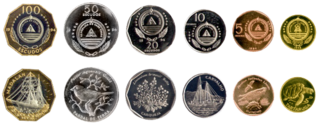This page is based on this
Wikipedia article Text is available under the
CC BY-SA 4.0 license; additional terms may apply.
Images, videos and audio are available under their respective licenses.
The peso is the currency of Chile. The current peso has circulated since 1975, with a previous version circulating between 1817 and 1960. Its symbol is defined as a letter S with either one or two vertical bars superimposed prefixing the amount, $ or ; the single-bar symbol, available in most modern text systems, is almost always used. Both of these symbols are used by many currencies, most notably the United States dollar, and may be ambiguous without clarification, such as CLP$ or US$. The ISO 4217 code for the present peso is CLP. It is officially subdivided into 100 centavos, although there are no current centavo-denominated coins. The exchange rate was around CLP$600 to 1 United States dollar at the end of 2014 and as of 1 April 2018.
The Portuguese escudo is the currency of Portugal prior to the introduction of the euro on 1 January 1999 and its removal from circulation on 28 February 2002. The escudo was subdivided into 100 centavos. The word escudo means "shield".

The cruzeiro was the currency of Brazil from 1942 to 1986 and again between 1990 and 1993. In 1994 it was replaced with the real. The name refers to the constellation of the Southern Cross, known in Brazil as Cruzeiro do Sul, or simply Cruzeiro. Visible only in the Southern Hemisphere, the Southern Cross is the main astronomical reference to identify the south and is a common cultural icon in Brazilian history.

The rupia was the currency of Portuguese India sometime after 1668 until 1958. Prior to 1668, the currency unit was Xerafim. In 1666, the Portuguese administration struck a silver coin calling it double xerafin and this was declared equal to a rupia in circulation in India outside of Portuguese possessions. A xerafim was a convertible subunit of rupia, and it was unique to Portuguese colonies in India. One rupia equalled two xerafims.
The metical is the currency of Mozambique, abbreviated with the symbol MZN or MT. It is nominally divided into 100 centavos.
The name metical comes from Arabic مثقال (mithqāl), a unit of weight and an alternative name for the gold dinar coin that was used throughout much of Africa until the 19th century.

The escudo is the currency of the Republic of Cape Verde.
The escudo was the currency of São Tomé and Príncipe between 1914 and 1977. It was equivalent to the Portuguese escudo and subdivided into 100 centavos.
The escudo was the currency of Angola between 1914 and 1928 and again between 1958 and 1977. It was subdivided into 100 centavos with the macuta worth 5 centavos and was equivalent to the Portuguese escudo.
The real was the currency of Portuguese Angola until 1914. It was equal to the Portuguese real. No subdivisions existed, but some coins were issued denominated in macutas, worth 50 réis. The real was replaced by the escudo in 1914.
The real was the currency of Argentina until 1881. From 1822, it was subdivided into 10 décimos. The sol was also issued during this period and was equal to the real, whilst the peso was worth 8 reales and the escudo was worth 16 reales.
The real was the currency of Portuguese Cape Verde until 1914. It was equal to the Portuguese real. Portuguese coins were used but banknotes were issued by the Banco Nacional Ultramarino specifically for Cape Verde starting in 1865. The real was replaced by the escudo, at a rate of 1000 réis = 1 escudo.
The escudo was the currency of Portuguese Guinea between 1914 and 1975. It was equal to the Portuguese escudo and replaced the real at a rate of 1000 réis = 1 escudo. The escudo was subdivided into 100 centavos. Portugal issued banknotes and coins for use in Portuguese Guinea. Following independence, the peso replaced the escudo at par.
The real was the currency of Portuguese Guinea until 1914. It was equal to the Portuguese real. Paper money specifically for Portuguese Guinea was first issued in 1909, supplementing Portuguese currency. Denominations were between 1000 réis and 50 mil réis.
The real was the currency of Portuguese São Tomé and Príncipe until 1914. It was equivalent to the Portuguese real. Coins were issued specifically for São Tomé and Príncipe until 1825 and banknotes were issued for the colony beginning in 1897. The real was replaced by the escudo at a rate of 1000 réis = 1 escudo.

The Azorean real, also known as the Azorean Moeda Insulana was the currency of the Portuguese archipelago of the Azores, used until 1931.
The escudo was the name of two distinct Spanish currency denominations.
In Cape Verde, the Cape Verdean escudo (CVE) became the national currency in 1914. It replaced the Cape Verdean real at a rate of 1000 réis = 1 escudo. The real was equal to the Portuguese real. Until 1930, Cape Verde used Portuguese coins, although in 1865, Portuguese notes were overstamped for use in Cape Verde, and in 1897, notes specifically designed for Cape Verde were introduced, in denominations of 1000, 2500 and 5000 réis. Notes for 10,000, 20,000 and 50,000 réis followed in 1909.

The first official currency of Brazil was the real. Its sign was Rs$. As the currency of the Portuguese empire, it was in use in Brazil from the earliest days of the colonial period, and remained in use until 1942, when it was replaced by the cruzeiro.








